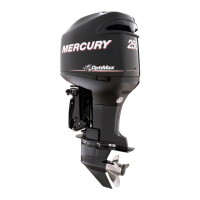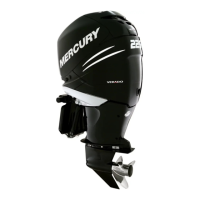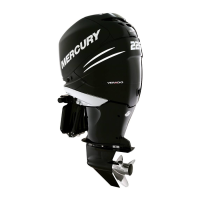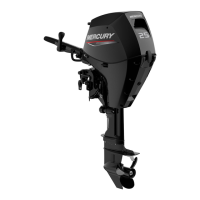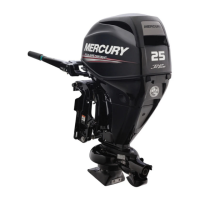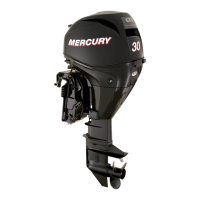FEATURES AND CONTROLS
26
WARNING SYSTEM ACTIVATED
If the warning system is activated, immediately reduce engine speed to idle. Shift outboard into neutral and visually
check for a steady flow of water discharging from the water pump indicator hole. If no water is flowing out, the
water pump is not working and the engine is overheating. See Engine Overheat, following .
If the water is discharging from the water pump indicator hole, stop the engine and check the oil level. A low oil
pressure problem may exist. See Low Oil Pressure.
ENGINE OVERHEAT
If the engine overheats, immediately reduce throttle speed to idle. Shift outboard into neutral and check for a steady
stream of water coming out of the water pump indicator hole.
If no water is coming out of the water pump indicator hole or flow is intermittent, stop engine and check the cooling
water intake holes for obstruction. If no obstruction is found, there may be a blockage in the cooling system or a
water pump problem. Have the outboard checked by your dealer. Operating the engine while overheated will cause
engine damage.
NOTE: Should overheating occur and you are stranded, stop the engine and allow it to cool down. This will usually
allow some additional low speed (idle) running time before the engine starts to overheat again. Operating an
overheated engine will cause engine damage.
If a steady flow of water is coming out of the water pump indicator hole and the engine continues to overheat,
consult your dealer. Operating an overheated engine will cause engine damage.
LOW OIL
The warning system will be activated if the oil pressure drops too low. First, stop the engine and check the oil level.
Add oil if necessary. If the oil is at the recommended level and the warning horn continues to sound, consult your
dealer. Engine speed will be limited to 2000 RPM, however you should not continue to run engine.
Power Trim and Tilt
Your outboard has a trim/tilt control called power trim. This enables the operator to easily adjust the position of the
outboard by pressing the trim switch. Moving the outboard in closer to the boat transom is called trimming in or
down. Moving the outboard further away from the boat transom is called trimming out or up. The term trim generally
refers to the adjustment of the outboard within the first 20° range of travel. This is the range used while operating
your boat on plane. The term tilt is generally used when referring to adjusting the outboard further up out of the
water. With the engine turned off, the outboard can be tilted out of the water. At low idle speed, the outboard can
also be tilted up past the trim range to permit, for example, shallow water operation.
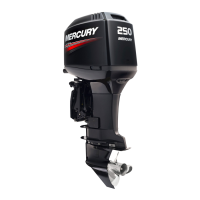
